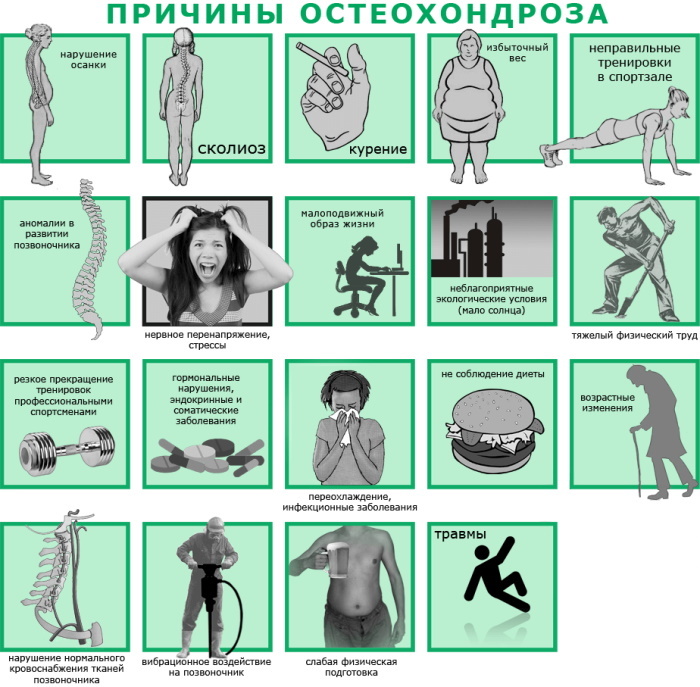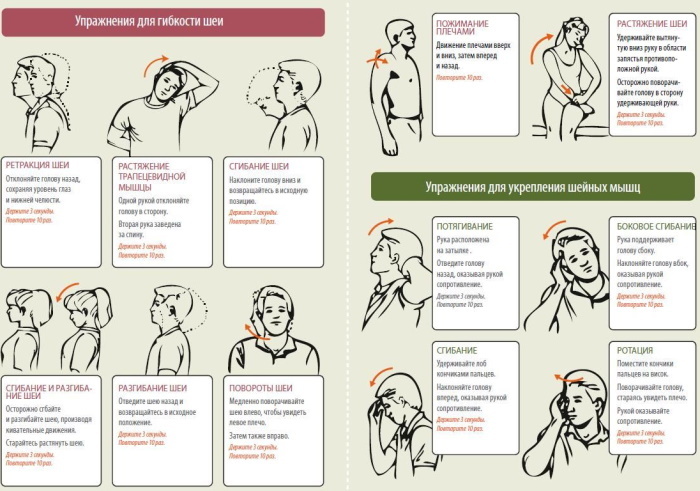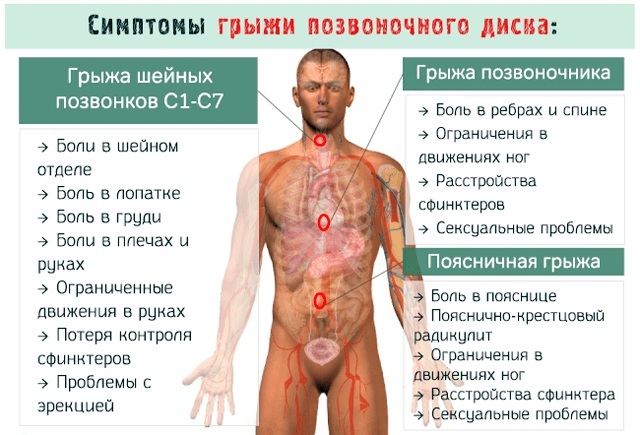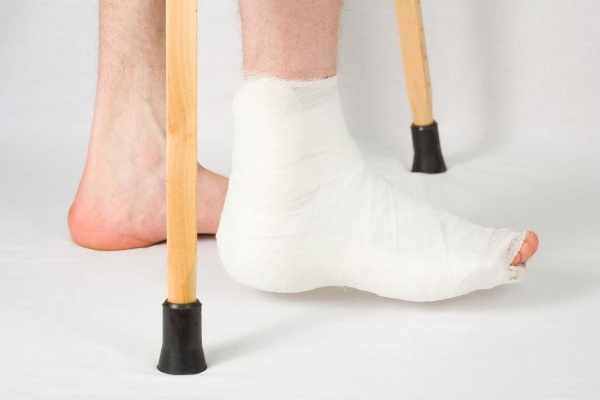Cervical chondrosis is a pathological condition the upper part of the human spine, which is characterized as a degenerative change in cartilage and bone tissue, which can lead to major health problems. Symptoms and treatment with drugs for this dysfunction of the spinal column will be studied in detail in the article.
Record content:
- 1 Stages and degrees
-
2 Symptoms and Signs
- 2.1 Headache
- 2.2 Dizziness
- 2.3 Pain in the neck
- 2.4 Blood pressure surges
- 3 Causes
-
4 Diagnostics
- 4.1 MRI
- 4.2 CT scan
- 4.3 X-ray
-
5 Treatment methods
- 5.1 Massage
- 5.2 Physiotherapy
- 5.3 Medications
- 5.4 Physiotherapy
- 6 Possible consequences and complications
- 7 Video about cervical osteochondrosis
Stages and degrees
Cervical chondrosis (symptoms and treatment with drugs of this problem require the intervention of doctors to exclude deplorable consequences) at an early stage of its development practically does not manifest itself with any painful signals.
Chondrosis of the neck is inherently a chronic, not too rapidly developing disease, and therefore its symptoms differ depending on the different stages. We give the manifestations of cervical chondrosis in the table below.

| Degree | Symptoms |
| The first | There is a slight decrease in the height of the intervertebral discs of the neck. Symptoms are poorly expressed and consist in the occurrence of discomfort, which, in addition to the neck, can also spread to the shoulder girdle. In some cases, slight pain occurs during exercise. |
| The second | The height of the intervertebral discs continues to decrease. Incorrect growth of cartilage also occurs, protrusions occur. The annulus fibrosus may already have cracks. The pain gets worse and longer. In addition, it begins to radiate along the spinal column and to the upper limbs. Stiffness is felt when turning the neck. A crunch and pain in the head are often heard. |
| Third | At this stage, the annulus fibrosus breaks and an intervertebral hernia is formed. In this case, the spine itself experiences severe deformation, which leads to the occurrence of dislocations and subluxations of the vertebrae. A person in such a situation has the most acute, long-lasting pain in the cervical region, loss of sensitivity of some areas of the skin (on the back of the head, on the shoulders, neck, arms). |
| Fourth | An extremely advanced stage of the disease, in which irreversible processes are already beginning to proceed. They consist in the development of numerous osteophytes, and the intervertebral discs undergo replacement by scar tissue. The hernias formed in this way compress the nerves and blood vessels lying nearby. Due to this, a person begins to feel hypoxia. The pathology of the circulatory system also develops. The neck and upper limbs are immobilized, which leads to a significant deterioration in the patient's quality of life. |
Symptoms and Signs
Cervical chondrosis (it is better to know the symptoms and treatment with drugs of pathology, since it haunts many people around the world today) is often disguised as other diseases.
In this case, the main manifestations of the disease are most often:
- Pain in the head.
- Dizziness.
- Pain in the cervical spine.
- Fluctuations in blood pressure.
Headache
A headache in the case of cervical osteochondrosis may be similar to a similar pain in the same arterial hypertension, stroke or angina pectoris. Especially when it comes to middle-aged or elderly people who have a very high risk of developing vascular abnormalities. In this case, the pain in the head can be dull, throbbing, or paroxysmal.
Dizziness
Particular attention should be paid to dizziness. Cervical chondrosis is characterized by systemic manifestations of dizziness, which consists in the sensation of a circular movement of nearby objects or the body.
These symptoms are a consequence of deviations in the work of the human vestibular apparatus, as well as visual analyzers. Treatment with drugs in such a situation can also be of significant help by improving blood circulation in the brain.
Pain in the neck
Neck pain is also a manifestation of osteochondrosis. At the same time, it is important to understand that a characteristic feature of this discomfort is their occurrence suddenly, for example, after sleep, as well as after performing sudden movements or tension.
The pain, which is associated specifically with chondrosis of the neck, usually subsides after a very short period of time, and even combined with a characteristic crunch in the vertebrae.
We must not forget: without a special preliminary examination, it is not recommended to relieve pain syndrome by resorting to the help of a chiropractor. This is due to the fact that the manipulation can be fatal and only aggravate the existing pathology and even lead to a person's disability.
Blood pressure surges
Also, a direct relationship between cervical osteochondrosis and blood pressure, or rather its jumps, has long been established and analyzed. This disease is characterized by fluctuations in the pressure of the human circulatory system, and not stable hypertension.
This is due to reflex irritation of the nerve endings and short-term vasospasm, which ultimately forms the frequent changes in the patient's pressure during the day.
With cervical ostechondrosis, increased pressure is certainly combined with the following symptoms:
- Pain in the limbs and chest.
- Decreased tactile sensitivity of the collar zone.
- Muscle tension and painful spasms.
Signs of cervical chondrosis are the following syndromes:
- Radicular, which manifests itself in pinching of the nerve bundles in the neck. The pain can radiate to the shoulder and shoulder blade.
- Vertebral, characterized by pain in the temples and occipital region.
- Reflex, manifested when the head moves and leads to pain in the head, chest, shoulders.
- Cardinal, resembling angina pectoris in its symptoms.
Causes
Cervical chondrosis, the symptoms and treatment of drugs of which are studied comprehensively, is inherently, to some extent, the payment of humanity for its ability to walk upright.
In the process of bipedal locomotion, the vertebrae put pressure on each other, and over the course of life, the connective tissue of people gradually degrades. Therefore, it is easy to understand why osteochondrosis is an inevitable process in older individuals. However, in addition to this, there are a number of reasons and factors that also contribute to the rather intensive development of the disease.
These included:
- Physical inactivity. It is no secret that a sedentary, sedentary life, which is observed everywhere today, leads to a slowdown in the body's metabolic processes and the formation of destructive processes in the spine.
- Lack of adequate physical activity.
- Unnatural, tense postures in the process of performing certain work (for example, while sitting at a personal computer).
- Excessively high physical activity, which is sometimes unnecessary for a person by his nature. In particular, this applies to professional athletes, metallurgists, miners.
- Being overweight, which contributes to increased stress on the spine.
- Increased nervous tension and stress, leading to muscle spasms and impaired blood flow.
- Hypothermia in the neck.
- Reasons leading to a deterioration in posture in general (incorrectly selected shoes, flat feet, scoliosis, sleeping in an uncomfortable position).
- Hereditary tendency.
- Autoimmune and endocrine diseases.
Diagnostics
Cervical osteochondrosis still has rather mild symptoms, which in turn very often intersect closely with other pathologies of the human body.
Therefore, the initial examination is recommended to be carried out by a therapist, neuropathologist and orthopedist. The doctor will study the patient's complaints, check the degree of neck mobility, as well as reflexes. In addition, he will pay close attention to the person's ability to maintain balance and examine the condition of the skin.
In the event that a primary medical opinion is delivered "cervical osteochondrosis", then an additional medical examination will be prescribed.
MRI
The most effective test is MRI - magnetic resonance therapy. It is based on nuclear magnetic resonance. Each human cell contains hydrogen atoms, which, under the influence of a strong magnetic field, begin to resonate and release energy, which the tomograph actually captures.
The information obtained in this way is processed by a computer and appears on the monitor in the form of an image. MRI creates a huge number of images, and in different spatial positions and planes, due to which even the most hidden pathologies can be identified. The cost of an MRI of the neck ranges from 4000 to 7000 rubles.
CT scan
Computed tomography ranks second in terms of the degree of accuracy in analyzing the state of the cervical vertebrae. The unambiguous advantage of this procedure in comparison with an X-ray is the lesser effect of radiation on the human body.
During the procedure, the patient is in the supine position and remains motionless. The duration of the examination is on average 2 minutes. In the presence of medical indications, a special contrast agent is injected into the blood intravenously, which contains iodine in its composition. The cost of the examination is about 5,000 rubles.
X-ray
X-ray examination of the cervical spine is the cheapest in terms of its cost, but also the most unsafe. At the same time, no preparation is required for this procedure. X-rays of the neck are taken while lying down, the pictures are taken in two projections. The cost of the procedure starts from 1400 rubles.
Treatment methods
Treatment of cervical osteochondrosis is reduced to an integrated approach, which is based on a combination of a number of measures, including:
- Medicines.
- Neck massage.
- Exercise therapy.
- Physiotherapy.
Surgical intervention is used only in exceptional cases when conservative treatment does not give the desired result or there is a direct threat to human health and life.
Massage
It accelerates and improves blood circulation in the neck, and also reduces the likelihood of spasms. by reducing muscle tone, massage also relieves pain and improves overall well-being person. But trusting to do massage is necessary exclusively for a professional, since an inept and rude effect on the neck can only aggravate an already difficult situation.
In this case, the main massage movements will be:
- Stroking - affects the upper layers of the skin.
- Trituration - warms up and relaxes the skin, improving the blood supply to the collar zone.
- Squeezing - impact on the deep layers of the neck muscles and stimulates the metabolism in the cartilage tissue.
- Kneading - requires extremely careful execution, as it greatly activates blood flow in the cervical spine.
Physiotherapy
To combat osteochondrosis of the neck in medicine, the following procedures are provided:
- Magnetotherapy.
- Electrophoresis.
- Laser therapy.
- Shock wave therapy.
- Mud therapy.
- Healing showers and baths.
Medications
In the fight against cervical osteochondrosis, the following groups of medicines are actively used:
- Chondroprotectors. Their task is to accelerate the regenerative processes taking place in the damaged cartilage of the neck. These drugs are used in a course of 2-3 months in an amount of at least 1000 mg per day.
- Vasodilators. Designed to accelerate blood microcirculation.
- Anti-inflammatory drugs. They help relieve pain and reduce inflammation. These medicines are taken strictly according to the doctor's prescription.
- Antispasmodics. Eliminate muscle spasm and reduce pain. They are used exclusively for relieving pain.
- Analgesics.
Physiotherapy
Physical therapy deserves special attention. The list of basic exercises includes several basic options that have proven to be effective in practice.
Head tilt to the side:
- Sit down or stand upright.
- Gently tilt your head to your shoulder and feel the neck muscles stretch.
- Make an exposure for 10-15 seconds.
- Slowly take the starting position.
- Repeat the exercise in the opposite direction. In this case, it is important to prevent the occurrence of pain syndrome.

Turning the head to the side:
- Comfortable to sit and stand.
- Lower your head down and try to reach the jugular cavity with your chin.
- Turn your head to the right, trying to slide your chin along the upper sternum.
- Make a delay of 3-6 seconds.
- Turn slowly in the opposite direction.
- Run 5-7 times in each direction.
Shoulder movement:
- It is necessary to sit or stand upright, while relaxing and lowering the shoulders.
- Raise your shoulders and move them forward.
- Return them to their original position.
- Pull your shoulders back, trying to close your shoulder blades.
- Take the starting position again.
- Repeat the cycle 6-8 times.
Resistance exercise:
- Sit exactly at the table.
- Put your elbow on the tabletop and rest the palm of the same hand on the temple.
- Move your head forward, lightly pressing on it with your hand.
- Repeat 10 times and change hands.
The following exercises look like this:
- Raise your shoulders as high as possible and hold them for about 10 seconds, then completely relax and take a breath. Repeat 10 times.
- Use your fingertips to stretch the back of the head. At the same time, perform the movements intensively and deeply, but without causing pain to yourself. Execution is allowed both sitting and lying down.
- Stand straight with feet shoulder-width apart and parallel to each other. Bend your knees slightly. Hands at the waist. Try to reach the sky with the top of your head. Thus, the vertebrae of the cervical spine are stretched.
Possible consequences and complications
Cervical chondrosis, the symptoms and treatment of which is important to monitor under the guidance of the attending physician, is dangerous when it proceeds without supportive therapy from the patient. This is due to the fact that in the neck area there are many blood vessels and nerve endings that directly affect the work of all organs and systems of the body.
Therefore, if you do not deal with the treatment of cervical osteochondrosis, then a number of negative points may arise, including:
- Migraine. Narrowing of the vertebral artery due to chondrosis leads to oxygen starvation of the brain and, as a result, headaches.
- Deterioration of vision. Compression of the vessels that provide nutrition to the organs of vision leads to a decrease in visual acuity.
- Hearing impairment. In especially advanced cases, chondrosis can completely deprive a person of hearing, but most often this figure is in the range of 20-30%. At the same time, it is recommended not to watch TV loudly or use audio players.
- Hypertension or hypotension. High blood pressure can lead to disturbances in sleep, metabolism and heart function. Hypotension, in turn, significantly impairs the quality of a person's life, causing him to lose strength.
-
Intervertebral hernia. They can cause a deterioration in the blood supply to the brain and even lead to ischemic stroke. In addition, a person may feel numbness in the hands, their weakness, and darkening in the eyes.

In conclusion, we note that cervical chondrosis is ranked among those diseases, from which it is impossible to get rid of completely in practice. Symptoms and drug treatment of this negative process must be closely monitored, which will make it possible to minimize the negative consequences of the disease.
As the basis for the fight against osteochondrosis, you should take the correct lifestyle, which includes balanced nutrition, thoughtful physical activity and maintaining optimal body weight body. All this in total is able to get rid of problems with the musculoskeletal system and ensure a high quality of life for many years.
Video about cervical osteochondrosis
Here is what he is cervical osteochondrosis:



